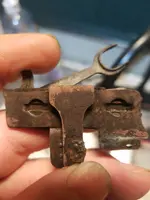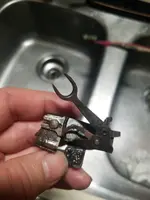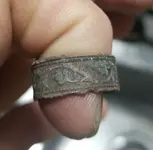The copper-alloy ring would have been plated at one point. I know some marks where to fool people but I never heard of a 8K, only 9, so that's an strange marking to use.
googling it I found out the region in and around Germany made the 8k gold.
It’s true that 8k gold could be from Germany (also Denmark and Greece among others) but German 8k gold is usually marked as ‘8c’ (ie with ‘c’ for ‘carat’ rather than ‘k’ for ‘karat’) or with the metric ‘333’ mark for 33.33% gold. Either mark would usually be accompanied by an official city assay mark. I think your ring is more likely to be American, from before 1906, and could be gold-fill rather than solid.
I’ve covered some of this before in other posts, but:
American standards for precious metal marking have long been an unholy mixture of self-regulation without official assay, consumer protection regulation of descriptions to prevent purchasers being misled, and mandatory technical standards relating to composition, compounded by inadequate policing. Although America has operated with 10k as the minimum standard for something to be called “gold” for over 100 years, that hasn’t always been the case, and particularly not prior to the “National Gold and Silver Stamping Act of 1906”.
Prior to 1906 many American manufacturers produced inexpensive gold rings to satisfy the cheaper end of the market using the lesser standards of 8k or 6k and marked them as such. In some cases, the rings were also stamped “Solid Gold”, which was justified as an assurance that the customer wasn’t getting gold-plate. Although perfectly legal, in reality it was a cynical marketing ploy which belied the fact that the actual gold content was ‘inferior’ and relied on purchasers not understanding the difference between “solid gold” and “pure gold”.
Both ‘6k’ and ‘8k’ stamps were also used on plated rings (gold-fill/rolled gold, not electroplate), often with no maker mark since it wasn’t obligatory at the time. Such rings may not have any indication that they’re plated… hence the evolution of the term “solid gold”, ostensibly to differentiate non-plated rings and elevate their perceived value.
Larger and more reputable companies such as Ostby & Barton and the Providence Ring Manufacturing Company produced such rings (both solid and plated) for the wholesale trade but tended to try and distance themselves from shoddy practices of smaller makers and misleading descriptions at retail level by either omitting their maker mark or not using karat marking (both legally permissible at the time). For example, the Providence Ring Manufacturing Company produced such items between 1898-1905 with no karat mark, but their catalogue states that their “Solid Gold” marked rings are either 6 karat or 8 karat gold. The 8k rings were listed at $15 per dozen.
From 1906 onwards the US Silver & Gold Stamping Act curtailed the production of cheap “solid gold” rings that were below 10k and generally tightened up the way in which karat marks could be applied to gold-fill.







